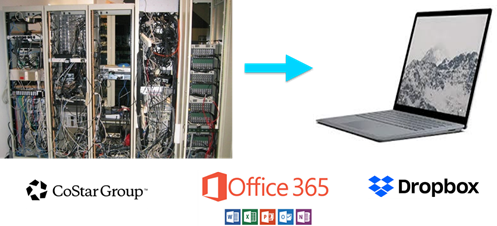The internet is having its moment.
As we’ve all shifted from our normal routines to leading lives in isolation, somehow, we’ve all managed to stay connected. While our physical worlds have gotten much smaller, our digital worlds have significantly expanded.
House parties, Zoom happy hours, and FaceTiming with family members have become the norm for keeping socially active. As a result, technology has been introduced to generations of users who would have otherwise gone about their lives never wanting, or needing to figure out how to unmute on Zoom.
One thing is for sure, had this happened 10 years ago, we would be looking at a much less connected society and many businesses would not recover. Why?
Download DIGITAL SOLUTIONS FOR BUSINESS CONTINUITY DURING AND POST COVID-19 here.
Broadband proliferation and the rise of the cloud.
Any sense of business normality is due to that fact that companies have leveraged connectivity and shifted to cloud computing. This began to happen 5-10 years ago and has enabled a rise in remote work and telecommuting. Suddenly, employees had the ability to work anywhere and stay plugged into their corporate tech stack, as it was accessible anywhere in the world with an internet connection.
But no business was fully ready to transition an entire workforce to remote.
To understand how businesses can grapple with this shift and where we go from here, we first need to look at how we got here.
The road to the Cloud
At the onset of businesses adapting to the rise of personal computing and the internet, the networks were hyper local. Offices were equipped with massive IT closets storing email servers, phone systems, document storage hardware, and application servers containing all the tools we used to operate our businesses daily. In the years following the dot com bust, digital innovation accelerated at a pace that most had a tough time keeping up with.

Traditional IT Closet
The IT closet became larger, more unruly, and IT operating costs became unsustainable. The problem was clear. Our need for more connectivity, more computing power, and more applications became too much for traditional IT teams to handle and one the traditional IT closet just couldn’t scale. Like most problems in the nascent digital world, the solution became obvious as the internet began to proliferate, and higher speed connectivity became more widely available.
What if we could use the internet to access all those same resources without the headache and cost of managing them ourselves?
Enter cloud computing
The concept was simple, use the internet to access all those tools that we need to operate our businesses. Rather than paying for all of that hardware and tech, we could subscribe to it as and when we need it. Businesses rushed to make the shift and “Cloud Transformations” were born.
The business case for a Cloud Transformation was clear - less capital investment for tech, more scalability, and outsourced IT management; all enabling businesses to pay for what they need, when they need it, without the cost of hardware or staff to manage the equipment.
For most businesses, the cloud transformation process started 5-10 years ago, and as the IT closet became smaller, the data pipes that we needed to access the cloud began to get much bigger. Rather than needing that IT closet full of equipment, businesses instead needed ultra-fast, reliable internet connections to operate their businesses.
As a result, we’ve seen the cost of internet downtime has skyrocketed to $300,000 per hour for the majority of businesses, with 1 in 3 estimating the cost to be $1-5 million per hour.
For the enterprise, higher speed connections, guaranteed service levels, and redundancy of services were the simplest means of accessing all those resources in a consistent way.
For the property industry, this meant your building needed to be well connected to attract and cultivate businesses; as every business became a tech business, fully reliant on connectivity to the cloud for all of the tools needed to operate.

Cloud Transformation
Cloud Continuity in the COVID-19 world
No business has been immune to the challenges presented by COVID-19.
Embracing the shift to digital isn’t as easy as getting your employees more Zoom licenses. It has been a watershed moment depending on what end of the digital spectrum your business sits on. In the COVID-19 world, there are three types of enterprises on the digital spectrum.
- On one end are businesses who were fortunate enough to start in a world where “cloud first” was the norm. These companies were always able to leverage cloud resources to grow their business and transitioning to remote work has been largely painless.
- In the middle are those who have spent the last 5-10 years painstakingly undergoing significant digital transformations, pushing their systems to the cloud and simplifying their tech stack. These enterprises have been rewarded with a large degree of “normalcy” in their day to day operations throughout this crisis.
For both of these companies in the COVID-19 world of remote work, employees can easily access their databases, CRMs, and all of the tools that they need to be effective on a daily basis. - On the other end of the spectrum, are the enterprises that have been prevented from solidifying a digital strategy leveraging cloud infrastructure due to cost, complexity of their enterprise IT stack, or specific business needs that aren’t a fit for the cloud.
In the COVID-19 environment, these companies are grinding to a halt; the massive shift to remote work has left these employees frustrated with choppy VPN connections and some of their systems completely inaccessible. Believe it or not, this group is the majority.
Download DIGITAL SOLUTIONS FOR BUSINESS CONTINUITY DURING AND POST COVID-19 here.
It's not all in the Cloud
While almost all businesses use the cloud in some ways, only 22% of enterprises use strictly “public cloud” infrastructure, which can be accessed with a simple internet connection over the public internet. The majority of businesses in the world still have some systems stored in the office/on-premises or in a mix of private/public data centers. This means that they are still using the “cloud” but users need to connect to their systems over corporate networks or intranets.
This is known as the “Hybrid Cloud” approach. This isn’t necessarily because they have neglected to see the promise of cloud, but they have selected portions of their enterprise tech that makes sense to be Cloud only, while other portions make sense to be managed internally and onsite.
Two main drivers are latency and security. Companies that require low latency connections may store on premise because they need to access these services extremely fast, where the milliseconds it takes to connect with a data centre miles away could mean millions of dollars. This is known as the shift from the Cloud to the “Edge”, where data can be processed quicker because of the equipment onsite. That’s why only 18% of financial services companies rely on public cloud only, as speed is everything when dealing with financial transactions.
Another main driver is security. Businesses in the healthcare or accounting sectors may require additional security from a corporate compliance standpoint, requiring some systems to sit behind company firewalls on site.
Many businesses, especially Fortune 500s, have simply been prevented from migrating fully to the cloud due to cost. The process isn’t as simple as flipping a switch, it takes years of planning and significant investment.
The majority of issues that businesses are currently facing are really driven by two issues: access and security.
This dynamic between cloud and onsite storage poses the challenge of access for the everyday employee. The problem is that all those systems are designed for local and tightly managed access. In a remote work environment, when employees need to access these systems to function, this can cause operations to come to a grinding halt.
JP Morgan faced backlash when the outbreak first began as traders were forced to come to the office as they weren’t able to support a full shift to remote work, resulting in 20 traders contracting the virus on one trading floor.
For all of these businesses, the near term solution to their digital woes can be alleviated by the very same thing that helped to jump start the shift to cloud computing - connectivity.
What does that mean for your business?
As we slowly transition back to the office and bifurcated work locations, it will be important to take a hard look at your tech stack and come up with a plan to optimise and prepare for a more tailored, flexible approach to cloud connectivity.
For the companies who have been prevented from migrating to the cloud due to cost, we will likely see the purse strings open up for full, but tailored cloud migrations. Tailored cloud services will be the mindset of the future.
All of the connectivity features in our downloadable guide are offered in the market today and many internet service providers (ISP’s) will tailor a solution using some of these elements to help your business through this period of adjustment. This will require some connectivity augments in your office building, but it’s never too late to fix the problem.
What does all of this mean for the property sector?
For the property sector, COVID-19 will usher in significant changes in tenant IT due diligence, connectivity requirements, and resiliency of digital infrastructure to support businesses in a cloud reliant environment.
Regardless of the tenant, there will be a focused emphasis on more complex connectivity requirements, using a mixture of edge, hybrid, and cloud computing to ensure businesses can continue uninterrupted in a fully remote or redistributed workforce environment. This will mean not just knowing what providers you have in your building, but what services they actually offer. Many buildings have multiple providers, but none that can offer more complex services like dark fiber or burstable bandwidth that we outline in the guide.
As tenants begin to shift back to their offices or satellite locations, many will be forced to make immediate changes to their existing connectivity to adapt to a redistributed workforce or a potential swing back to fully remote work. To enable your tenants to be successful, be sure you have a full handle on what providers you have in your building and what services they offer, to arm your tenants for success.
Download our TECHNICAL SOLUTIONS TO ENSURING BUSINESS CONTINUITY DURING AND POST COVID-19 here.
#ConnectivityMatters





 Back
Back